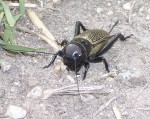
So as the cautious man (or my mother) says, “Safety first.” However, for the male cricket–as gallant as he is–he’ll risk his life for a lady friend. In danger, a male cricket will wait until his female partner dives into their hiding burrow to ensure that if she’s pregnant, his genes will survive.
At the entrance, it’s ladies first: the male cricket waits while his partner dives in first. It’s a delay that could cost him his life. This may all seem very chivalrous, but the male’s seemingly selfless actions also make selfish sense. He may die, but he ensures that his genes pass on to the next generation.
Male insects often stay close to female ones after they mate, and people have generally assumed that they’re standing guard. If the female mates again, the first male’s sperm will be flushed out by the second male’s contributions. If he wants to ensure that he fathers he offspring, he’d do well to keep other suitors at bay.
But Rolando Rodriguez-Munoz from the University of Exeter found that this narrative of conflict doesn’t quite work for field crickets. He set up a network of infrared cameras to study a wild population of the crickets that had all been individually marked and genetically analysed. The cameras recorded thousands of hours of video, and Rodriguez-Munoz watched them all.
 So as the cautious man (or my mother) says, “Safety first.” However, for the male cricket–as gallant as he is–he’ll risk his life for a lady friend. In danger, a male cricket will wait until his female partner dives into their hiding burrow to ensure that if she’s pregnant, his genes will survive.
So as the cautious man (or my mother) says, “Safety first.” However, for the male cricket–as gallant as he is–he’ll risk his life for a lady friend. In danger, a male cricket will wait until his female partner dives into their hiding burrow to ensure that if she’s pregnant, his genes will survive.
No comments:
Post a Comment